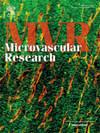Influence of pericyte-like vessel dilation on RBC flux in an In Vitro microvascular network
IF 2.7
4区 医学
Q2 PERIPHERAL VASCULAR DISEASE
引用次数: 0
Abstract
Efficient oxygen delivery in the brain relies on a finely tuned balance between vascular architecture and dynamic flow regulation. While red blood cells (RBCs) passively flow through the capillary network, neurovascular coupling ensures that the blood supply adapts to meet the metabolic demands of active neurons. Pericytes, contractile cells embedded in the capillary walls, play a key role in this process by modulating capillary diameter in response to neural signals. While pericytes are believed to enable rapid and localized blood flow regulation, their contributions in time and space remain debated. This study investigates the effects of pericyte-like vessel dilation (i.e., pericyte relaxation) on RBC distribution and flow dynamics using an in vitro microfluidic model. We investigate how pericyte-induced dynamic cross-sectional changes affect RBC distribution and velocity in a capillary network. By employing a programmable pressure pump to simulate gradual variations in capillary diameter, we observed that short-time dilation increased RBC velocity and hematocrit near the dilation site, enhancing localized perfusion. In contrast, prolonged dilation led to a network-wide RBC redistribution minimizing hydraulic resistance, ultimately depleting hematocrit due to the network Fåhræus effect. These findings highlight the dynamic and adaptive nature of capillary blood flow, where sustained localized changes can propagate into systemic effects over time. More broadly, this study provides new insights into the interplay between localized flow regulation and systemic capillary network dynamics, revealing how geometric and dynamic factors govern RBC behavior and perfusion.
周细胞样血管扩张对体外微血管网络中红细胞通量的影响。
大脑中有效的氧气输送依赖于血管结构和动态血流调节之间的精细平衡。当红细胞被动地通过毛细血管网络流动时,神经血管耦合确保血液供应适应活跃神经元的代谢需求。周细胞,嵌入毛细血管壁的可收缩细胞,通过响应神经信号调节毛细血管直径,在这一过程中发挥关键作用。虽然周细胞被认为能够实现快速和局部的血流调节,但它们在时间和空间上的贡献仍然存在争议。本研究利用体外微流体模型研究周细胞样血管扩张(即周细胞松弛)对红细胞分布和血流动力学的影响。我们研究周细胞诱导的动态横截面变化如何影响毛细血管网络中的红细胞分布和速度。通过使用可编程压力泵模拟毛细血管直径的逐渐变化,我们观察到短时扩张增加了扩张部位附近的红细胞速度和红细胞压积,增强了局部灌注。相反,长时间的扩张导致整个网络范围内的红细胞再分布,使水力阻力最小化,最终由于网络f hræus效应而消耗红细胞压积。这些发现强调了毛细血管血流的动态和适应性,随着时间的推移,持续的局部变化可以传播成全身效应。更广泛地说,这项研究为局部血流调节和系统毛细血管网络动力学之间的相互作用提供了新的见解,揭示了几何和动态因素如何控制红细胞行为和灌注。
本文章由计算机程序翻译,如有差异,请以英文原文为准。
求助全文
约1分钟内获得全文
求助全文
来源期刊

Microvascular research
医学-外周血管病
CiteScore
6.00
自引率
3.20%
发文量
158
审稿时长
43 days
期刊介绍:
Microvascular Research is dedicated to the dissemination of fundamental information related to the microvascular field. Full-length articles presenting the results of original research and brief communications are featured.
Research Areas include:
• Angiogenesis
• Biochemistry
• Bioengineering
• Biomathematics
• Biophysics
• Cancer
• Circulatory homeostasis
• Comparative physiology
• Drug delivery
• Neuropharmacology
• Microvascular pathology
• Rheology
• Tissue Engineering.
 求助内容:
求助内容: 应助结果提醒方式:
应助结果提醒方式:


